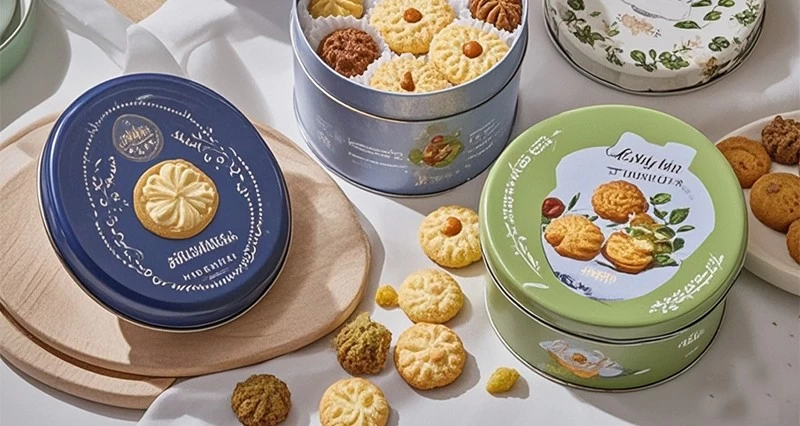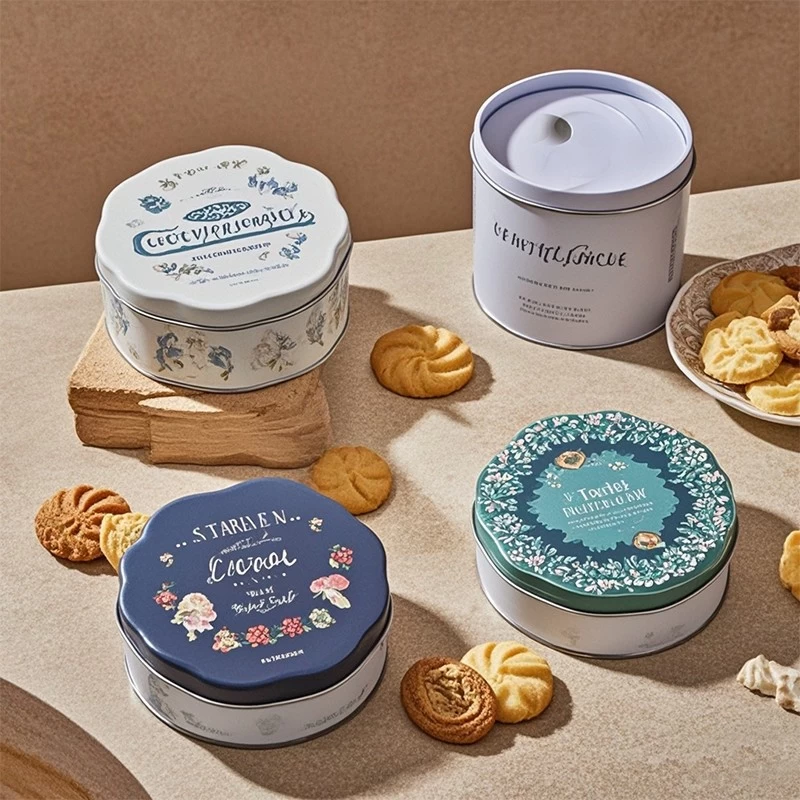This year we carefully created a PU leather handle coffee tin box for the coffee brand. The size is 185x136x85mm. It is made of food-grade tinplate and the material thickness is 0.23mm.
This year, Cosmetics Brands joined hands with our professional tin box manufacturer to create a cosmetic tin box with handle that combines beauty and practicality. This is not only a container for beautiful things, but also an ode to a refined attitude towards life.
The Xmas detachable candy balls is made of tinplate, the iron box is strong and durable. It is not easy to open directly, you can easily open the hemisphere without the string by pulling the string. The Christmas ball can be used as a candy jar, and the candy ball has enough space for candies, chocolates, trinkets, and small things. At the same time, its lovely shape and hanging ribbon are also perfect for Christmas tree decoration
Material and safety Food-grade tinplate material, light and durable, drop-proof and rust-proof, in line with food safety standards. The interior adopts environmentally friendly coating, no odor, and can directly contact food. Customized printing Full-surface high-definition printing: supports single-sided/double-sided customization of corporate logos, patterns, slogans or art designs. Process selection: silk screen printing, hot stamping, UV embossing and other processes are optional to enhance the brand texture. Applicable scenarios: employee benefits, event gifts, promotional gifts, campus customization, etc.
Our round tin cookie box is an elegant and practical packaging solution designed to keep your cookies fresh and beautifully presented. Made from high-quality tinplate, it offers excellent durability and protection against moisture and breakage. The smooth, classic round shape adds a touch of sophistication, making it perfect for gifts, festive treats, or everyday storage. With customizable designs, sizes, and finishes, this tin box not only preserves the delicious taste of your cookies but also enhances your brand’s image with eye-catching, reusable packaging.
This heart-shaped tin box is made from food-grade material, making it safe for storing a variety of candies and gifts. Perfect for the holiday season, this charming tin adds both function and holiday cheer to any celebration.
These discreet low profile rectangle tins feature a clean & fresh style that will remain modern for many uses to come. Our lightweight durable containers are made from high-quality material. Reliable hinge & seal for a perfect closure every time. General household organizing, crafts, homemade packaging, store spices, tea leaves, coffee beans, chocolates, mints, creams, balms, gels, jewelry, beads, sequins, recipe cards, arts, medicines, pills, lip balm, cosmetics, gifts, party favors, Double button locking hinged lid that offers great child resistant packaging.
Designed for exquisite chocolates, our custom food-grade rectangular chocolate tinplate boxes provide safe, beautiful and highly flexible packaging solutions. This packaging box is strictly made of high-quality tinplate materials that meet food contact safety standards (such as FDA/GB) to ensure that the contents are pure and uncontaminated. The classic rectangular design is not only simple and elegant in appearance and full of modernity, but also can efficiently utilize space, making it easy to stack, transport and retail display. The core advantage lies in its deep customization service - you can freely choose the box size, color (internal and external coating), pattern printing (high-definition color printing, hot stamping/silver, etc.), and lining material (such as food-grade white cardboard tray, PET blister tray, flannel, etc.), perfectly carrying and enhancing the value and protection of your brand chocolate. The sturdy iron box structure provides excellent sealing and moisture-proof performance, effectively extending the freshness and shelf life of chocolate, and is an ideal packaging choice for high-end chocolate brands, gift markets and baking industries.
The printing principle of custom printed cookie tin box is mainly based on offset lithography. The tin box printing process uses the physical properties of water and ink repelling each other, and with the help of printing pressure, the printing plate image is transferred to the tin box through the rubber cloth. Due to the special physical and chemical properties of tinplate boxes and the reprocessing performance of printed products, its printing process is quite different from ordinary offset printing. After completing all the color registration, a layer of bright oil needs to be covered on the surface of the printed tin box to increase the glossiness of the printed product surface. At the same time, it can also improve the hardness of the product surface, so that the printed ink layer has a certain flexibility and corrosion resistance, thereby producing beautiful and eye-catching tin box printing packaging.

There are various ways to print tinplate, including four-color printing, spot color printing, and white printing. Four-color printing uses yellow, magenta, cyan and black ink to copy the various colors of the color original. Since cyan and blue are similar, the popular saying is black, red, blue and yellow. Spot color printing is a pre-mixed color, which is directly selected by the customer. White printing is to print a part in white, and keep the original color of the tinplate in other places. White porcelain is all white.
In tin box printing, the ink is required to have good adhesion and mechanical properties. Since tinplate printed products need to be made into food cans, etc., they need to be cut, bent and stretched, so the printing ink needs to have good adhesion to tinplate and the corresponding machines. Before printing, it is usually necessary to paint the tinplate white. White is the basic color of all pictures and has a high brightness. After adding other high-energy tones, the brightness of each tone can be increased to form a color gradient. At the same time, there are also requirements for white ink. It must have good adhesion with the primer, not yellow after repeated high-temperature baking, and not fade after high-temperature steaming. The commonly used primer is epoxy amine type, which has the process properties of light color, no yellowing after multiple baking, no aging, good flexibility and impact resistance.
Process flow of customized printed cookie tin box
The printing process flow of customized cookie tin box is relatively complicated. First, the tinplate is dusted and decontaminated to remove oil and impurities on its surface. Then the powder spraying and burning are carried out, and the water-absorbing micropowder is evenly sprayed on the surface of the tinplate, and then open flame burning is carried out to obtain the pretreated tinplate. After that, the inner coating is applied to the inner side of the pretreated tinplate by a coating machine and dried in a vacuum environment. Then the ink is printed on the cooled coated semi-finished product by an offset printing machine. The printing temperature is generally 20-26 degrees, and ultraviolet rays are used to irradiate until 70-80% dry, and then completely dried in a vacuum. Finally, it is cooled and formed to obtain the printed product. Throughout the process, the parameters and conditions of each link need to be strictly controlled to ensure the printing quality.
For example, in the powder spraying and burning process, the selection and spraying amount of water-absorbing micropowder will affect the subsequent printing effect; in the printing and baking process, the printing temperature, ultraviolet irradiation intensity and drying conditions need to be precisely controlled, otherwise it may cause problems such as insufficient ink adhesion and uneven color.

Tinplate printing methods
There are many ways to print tinplate. The most common one is four-color printing, which is also called offset printing in professional terms. Different patterns are printed by matching the four quasi-colors of black, red, yellow and blue. There is also spot color printing, which is a method in which the colors are prepared in advance and the customer directly selects and uses them. In addition, printing white is also a method, that is, printing a part in white and retaining the original color of the tinplate in the other parts. In addition, white magnetic printing is to lay a layer of white primer on the entire tinplate surface and then print the pattern.
In practical applications, the choice of printing method depends on design requirements and cost considerations. For example, if the pattern color is more complex and requires high precision, four-color printing may be selected; if a large area of a single color or a specific spot color effect is required, spot color printing is more suitable.
Requirements for inks in cookie tin box printing
Cookie tin box printing has special requirements for inks. First, the ink needs to have good adhesion and mechanical properties, because the tin box may undergo cutting, bending and stretching processes in the future. Secondly, there are high requirements for white ink, the whiteness must meet certain standards, and it must have good bonding with the primer, and it must not turn yellow after multiple high-temperature baking, and it must not fade after high-temperature steaming. In addition, in addition to having a certain degree of water resistance, the color ink must also be thermosetting, and the coloring power and durability of the pigment are also relatively high.
For example, during the printing process, if the ink adhesion is insufficient, the pattern may peel off during subsequent processing or use; if the whiteness of the white ink is not enough or it is not well bonded with the primer, it will affect the overall printing effect and product quality.
The role of primer in cookie tin box printing
The primer in cookie tin box printing plays an important role. Primer can effectively seal the base layer, alleviate the "pan-alkali" phenomenon caused by strong alkalinity on the wall, and avoid the formation of crater-like protrusions or alkaline frost on the surface of the paint film, thereby destroying the paint film. Primer can also enhance the adhesion of the topcoat, improve the bonding strength between the latex paint film and the wall, and prevent the wall from peeling off. At the same time, primer can make up for fine cracks, improve the flatness of the wall, and make the printing effect better. In addition, the price of primer is relatively cheaper than that of topcoat. Applying primer before applying topcoat can save decoration costs.
For example, in some environments with high humidity, the sealing effect of primer is particularly important, which can effectively prevent wall problems caused by moisture penetration; for tin boxes with uneven surfaces, the filling effect of primer can provide a better foundation for subsequent topcoats.
The role of white in the printing of cookie tin boxes
In the printing of customized cookie tin boxes, white plays an important role. First of all, white is the base color of all pictures, with high brightness. After adding other high-energy hues, the brightness of each hue can be increased to form a color scale. Applying a white primer to the tinplate before printing can improve the vividness and clarity of the subsequent color patterns. Secondly, white can highlight the metallic luster. In the design where the metal texture needs to be partially transparent, a unique visual effect can be achieved by printing white ink primer in places where the metal texture is not required. In addition, full-page white printing can make the tin box have a bright appearance and enhance the overall aesthetics.
For example, some cookie tin boxes will cleverly use white primer and iron-through technology to highlight the metal texture of the brand logo or specific pattern; and for products that pursue a simple and bright style, full-page white printing can make them more attractive on the shelf.
In summary, custom printed cookie tin box packaging involves multiple links and processes, each of which has its specific role and requirements, and together serve to achieve high-quality and beautiful printing effects.